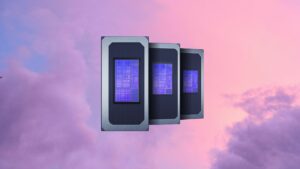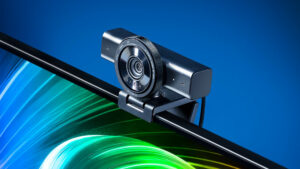A long-overdue upgrade.
A long time coming, the Philips Hue Bridge Pro fixes all of the issues with the older bridge: it supports more lights, more accessories and more scenes, and has a faster processor. If your old system was starting to have issues, then the Bridge Pro is an essential upgrade, and the migration (for single Bridges) is a dream to run. New users will find the Hue Bridge Pro a better starting point. New features, including Wi-Fi support and Motion Zones, which turn lights into motion sensors, are just an extra bonus.
-
Seamless migration for existing users
-
Faster and more powerful
-
Turns lights into motion sensors
Key Features
-
Supports more devices
Up to 150 lights, 50 accessories and 500 scenes.
-
Wi-Fi and Ethernet
More choice on how to connect the Bridge to your home network.
Introduction
A new smart home bridge isn’t usually that exciting; they’re important, but end up stuck out of sight. However, the Philips Hue Bridge Pro is not only important, it’s both very interesting and, for many homes, essential.
Adding new features, including motion sensing, while supporting additional lights, scenes and accessories. Whether you’re starting from scratch or have an existing installation, the Hue Bridge Pro is an essential part of this lighting system.
Design and Installation
- Easy migration
- Wi-Fi or Ethernet
Although most Philips Hue lights can be used over Bluetooth, if you’re serious about the smart lighting system you really need a Bridge. Allowing a greater number of devices, a Bridge also works when there’s no internet connection, so you can still control your smart lights via the array of wireless remotes even if you’re completely offline. That makes Philips Hue a genuine replacement to traditional lighting.
The second-generation Philips Hue Bridge has been a stable workhorse for 10 years, and will still be on sale. I’ve had one in my house since launch, and it has worked reliably and continuously.
The issue is that the Bridge only officially supports 50 lights and 12 accessories, such as dimmers and motion sensors. That might sound like a lot, but it’s surprisingly easy to hit these limits.
As I’ve extended Hue lights throughout my home, I’ve increased the total number of lights I have, with light strips, lamps and additional bulbs. I’ve also added additional controls where it’s most convenient to use them.
In my kitchen, for example, I have seven lights and two controls; the living room has three controls and five lights; and outside, I’m up to ten lights, three light switches and a motion sensor.
As I’ve continued to grow the number of lights, and add extra scenes, the old Hue Bridge has started to creak. Adding new lights sometimes prompts the Hue app to tell me to remove another device, and I often can’t add new scenes. Then, there are the issues: sometimes lights take a while to respond to a wireless remote, and I’ve had a situation where wireless controls lose their association with a room.
While multiple Bridges are supported, they’re a pain to set up, as devices have to be manually moved between them, and only one can be used offline. The Hue Bridge Pro fixes all of that.
Externally, it looks similar to the old one, only it’s decked out in black. Inside, it’s a completely different beast with a new processor and more memory. Importantly, it also supports a lot more devices: 150 lights, 50 accessories and 500 scenes. Even in a busy house, like mine, that’s more than enough.


At the rear is an Ethernet port, although the Hue Bridge Pro also supports Wi-Fi. I used Ethernet, as I find it’s more reliable and I have the wiring in place.


If you’re starting from scratch, then the Hue Bridge Pro is added to a new system, and the installation is much as it was before. If you’ve got an existing Hue Bridge, then the app offers you the option to migrate lights.


Currently, this migration only works for a single Bridge, with support for dual Bridges coming soon.
I was a little worried about the migration, but I shouldn’t have been as Hue has nailed it. Within 20 minutes, all my Philips Hue lights, accessories and scenes were migrated. I had to manually move my Friends of Hue switches (the app explained exactly what to do), and I had to re-pair my Innr Globe outdoor lights. This latter step was much more painful, but that’s down to how Innr handles putting its lights into pairing mode.
However, the main thing to note is that the migration is painless, and Hue holds your hand all the way through the process.
Features and Performance
- Faster and more responsive
- New Motion areas
- Matter compatible
Once set up, the Hue Bridge Pro sits in the background and handles all of your lighting controls. As the system uses Zigbee, each light is a repeater, which means it’s easy to build out the network to cover a large area.
I have my Hue Bridge Pro installed in an understairs cupboard in the middle of a Victorian terraced home, and lights throughout the house, garden and into my garden office. I have no trouble with coverage, and lights in the garden office are just as responsive as the lights in the kitchen, which sit next to the Bridge Pro.
Most importantly, for me, the Bridge Pro has restored my lights and accessories to their normal speed. My kitchen dimmer, for example, sometimes needed a couple of presses to turn the lights on, but now works without fail on the first touch. And, its dimming controls work immediately.
I don’t have to worry about the number of scenes that I have now, either. With 500 to play from, each room and control can be loaded up with scenes, and they just work. In this regard, everything works as it should and as described in my Philips Hue review.
For me, that would be reason enough to upgrade alone, but the Hue Bridge Pro also adds some new features. First, the Bridge Pro now comes with a Matter code on the bottom, rather than an Apple Home one. Sure, the old Bridge was Matter compatible with a firmware upgrade, but it’s nice to have support baked in and the code printed on the bottom of the box.
Matter lets me add the Hue Bridge Pro directly to a smart home system of my choice, for direct control. That makes lights faster to respond when using a voice command with Amazon Alexa, for example, or when using the Apple Home app.
If you already have Matter set up with an old Bridge, as I did, then you have to start from scratch and pair the new Bridge Pro. That’s slightly laborious, but there’s no way around this.
I had to reboot the Bridge Pro after installing it to get Apple Home to connect, as the original pairing process timed out. Second time lucky, and all of my lights and controls came over and Apple’s Adaptive Lighting, which matches light colour temperature to the time of day, started working again; with my original Bridge, switching to Matter killed this integration and I could never make it work again.
While Philips Hue has a similar setting, I find the Apple integration works better and needs no configuration: there’s one icon to turn it one.
The Hue Bridge Pro can also turn lights into motion sensors with Motion areas. This technology monitors the Zigbee network and can spot interference, caused by people walking around. It’s similar to the technology used with WiZ lights (also owned by Signify).
However, the WiZ implementation uses Wi-Fi and doesn’t work very well with mesh networks; the Hue feature is independent of your network.
Creating a Motion Zone is easy, and requires three or four lights to work, ideally placed at different points and heights throughout a room. I set the system up in my office, using some of the lights in the Hue Centris and a light strip around my desk.


Motion Zones have sensitivity settings, and you can tell them which lights to turn on, and which scenes you want to use. There’s no light sensor available (although you can take a reading from a camera or an existing motion sensor), which you get with the motion sensor, but you can used Daylight settings so that the zones are only available between sunset and sunrise, with an offset available.
Time Slots can also be used to disable the motion sensing at certain times. For example, in a bedroom, you won’t want the lights coming on at night if you move, so you can create a time slot for when you sleep and tell the lights to ‘do nothing’.
Does the tech work? Yes, absolutely. In my office, the Motion Zone accurately detects when I walk in or move around, and the lights automatically turn off after 10 minutes of inactivity.
I do find this option slightly limiting in some cases. For example, in my office, I like a motion sensor with an integrated light sensor, so that my lights turn on automatically when it starts getting dark. In my kitchen, the motion sensing is really useful, although I had to change the mode from setting a scene to ‘Last on state’ so that motion didn’t override the scene I was currently using.
Ultimately, having the option to turn lights into motion sensors, even if you just use them to turn lights off automatically after a certain period, is a useful feature to have.
Should you buy it?
Buy if you want better performance
If you’ve got an existing Hue system that’s struggling under load, this is an essential upgrade; new users will find this a better starting point.
Don’t buy if you have a small Hue system
If your current system is well within the limits of the original Bridge, there’s not much reason to upgrade.
Final Thoughts
An essential upgrade for most existing Hue households and a better starting point for those starting from scratch, the Hue Bridge Pro is faster and supports more lights, scenes and accessories.
For existing users, its automatic migration makes it a no-brainer to upgrade, and the Bridge Pro comes highly recommended.
How we test
We test every smart home product we review thoroughly over an extended period of time. We use industry standard tests to compare features properly. We’ll always tell you what we find. We never, ever, accept money to review a product.
Find out more about how we test in our ethics policy.
- We test how each product integrates with other smart home systems including Amazon Alexa, Google Assistant, Apple HomeKit, IFTTT and Samsung SmartThings
- We use each smart home product in a real world setting, integrating it into our home.
FAQs
Yes, although you’d have to handle the job manually at the moment, as the migration tool only supports one Bridge for now, with support for two coming later.
Yes, and it has a Matter code printed underneath.
Full Specs
| Philips Hue Bridge Pro Review | |
|---|---|
| Manufacturer | Philips |
| Product Description | Smart lighting bridge |
| Size (Dimensions) | 92.3 x 92.3 x 26 MM |
| Release Date | 2025 |
| First Reviewed Date | 15/10/2025 |
| Model Number | Philips Hue Bridge Pro |
| Voice Assistant | Amazon Alexa, Apple Siri, Google Assistant |
| Networking | Ethernet, Wi-Fi, Zigbee |
Source link






